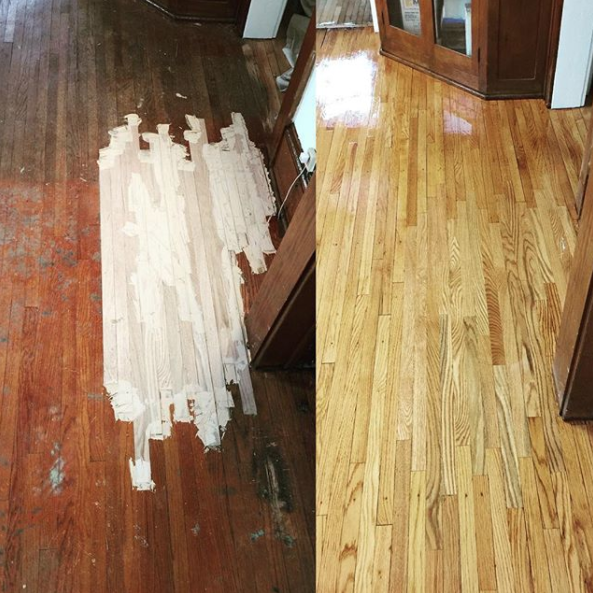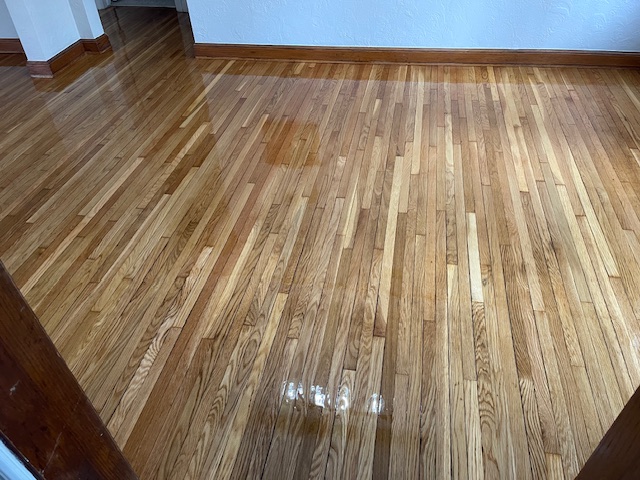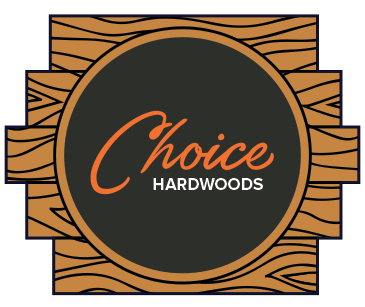Identifying Wood Floor Types

Wood Floor Types: What Species Does Your Home Have?
Older homes in Minneapolis were often built with hardwood floors that are now prized for their historical value and natural beauty. Several wood species were popular in home construction from the late 1800s to the early 20th century, each offering unique characteristics in terms of grain pattern, color, and durability.
Maple: Maple was one of the most commonly used hardwoods in homes built between the 1910s and 1940s. It’s known for its light, creamy color, which can range from pale yellow to a soft, reddish hue. The grain pattern is usually straight, but it can occasionally have a slightly wavy pattern. Maple is a dense and durable wood, making it ideal for high-traffic areas. However, it tends to show wear and tear more easily, especially in lighter finishes, because its natural grain is less forgiving when it comes to visible scratches.
Red Oak: Another highly popular species, red oak, has a distinct reddish-brown hue that deepens over time. Red oak has a prominent grain pattern that appears in broad swirls or stripes, creating a more textured look than maple. Red oak is strong and resilient, able to withstand the rigors of daily life. Its durability makes it ideal for both high-traffic areas and spaces that see a lot of furniture movement. One of the best features of red oak is its ability to take stain well, allowing it to be refinished and customized to match evolving design preferences.
White Oak: White oak is a harder, more durable wood than red oak, often found in homes built during the late 1800s to early 1900s. White oak has a lighter, yellowish-brown color and more subtle grain patterns than red oak. It is known for being highly resistant to moisture, which made it a favorite in Minneapolis homes that might experience seasonal humidity changes. White oak’s tight grain and darker tones lend it a more sophisticated look, and it has become increasingly popular in modern home renovations.
Pine: Pine was often used in homes from the late 1800s to the early 1900s, especially in areas where cost was a primary consideration. Pine is a softwood, making it less durable than other hardwoods like oak or maple. Its color varies from pale yellow to light brown, with distinct knots and grain patterns. Over time, pine floors can develop a beautiful patina, but they can also show signs of dings, dents, and scratches much more easily. This wood is ideal for creating a rustic, vintage look but may not be as long-lasting in high-traffic areas.
Cherry: Cherry wood is a rich, reddish-brown hardwood that is highly prized for its elegant appearance. It has a smooth, fine grain that creates a uniform look. Cherry is often used in high-end homes and can develop a darker patina over time, adding to its classic, timeless appeal. This wood is softer than oak, meaning it can be more susceptible to dents and scratches. However, its rich color makes it ideal for adding warmth and character to any room.
How to Differentiate Between Wood Species
Identifying the type of hardwood in your home can be tricky, especially when finishes and age have altered the appearance of the wood. However, there are several key features you can use to differentiate between species:
Color and Grain Patterns:
- Maple is typically light with a subtle, fine grain pattern, often straight or slightly wavy.
- Red Oak has a rich, reddish hue with a prominent, wavy grain pattern that is easy to identify.
- White Oak is more muted in color, leaning toward a light tan or yellowish-brown with subtle grain patterns.
- Pine tends to be light and yellowish, with obvious knots and a more erratic grain.
- Cherry has a reddish hue that deepens over time, with a smooth, fine grain.
Texture and Hardness:
- Maple and oak are dense and heavy, giving them a sturdy feel underfoot.
- Pine, being a softwood, is lighter and feels less rigid.
- Cherry is relatively softer than oak, but it still provides a smooth surface that feels less hard than red oak.
Grain and Visual Markings:
- Red oak tends to have visible swirl patterns that create more movement in the grain.
- White oak has a more straight-grain pattern that’s subtle and uniform.
- Maple usually has small, tight grains with an even texture.
- Pine is known for its more open grain and visible knots, giving it a natural, rustic feel.
How Choice Hardwoods Helps Identify Wood Species
When it comes to identifying hardwood species in your Minneapolis home, Choice Hardwoods is a valuable resource. Using a professional text kit, the experts at Choice Hardwoods can perform detailed analysis to help homeowners accurately identify the type of wood in their flooring.
The text kit is a diagnostic tool used by professionals to distinguish between species by analyzing the cellular structureand fiber composition of the wood. This process allows experts to quickly determine whether your flooring is made of maple, oak, pine, or another wood, even if the appearance has been altered by age, wear, or refinishing. This is especially useful in older homes where the original wood may have been modified over time.
In addition to identification, the experts at Choice Hardwoods can help you assess the condition of your existing hardwood floors and advise you on whether refinishing or replacing the flooring is the best option for your home.
Visual Differences, Durability, and Maintenance
In terms of durability:
- Maple and oak are highly durable and can withstand significant wear, although they require regular maintenance (such as refinishing) to keep them looking their best.
- Pine, being softer, tends to show scratches and dents more easily, and it may need more frequent maintenance.
- Cherry can develop a beautiful patina over time, but it’s softer than oak and may be more vulnerable to wear in high-traffic areas.
Maintaining these woods typically involves regular sweeping or vacuuming to prevent grit buildup, along with periodic refinishing to restore the wood’s natural luster. Understanding your wood species helps in choosing the right cleaning and care techniques. For example, red oak and white oak benefit from specialized products designed to maintain their finish, while pine might need more gentle cleaning solutions to avoid excessive wear.

Pros And Cons Of Your Floor Species
When selecting hardwood flooring for your home, it’s essential to understand the unique characteristics of each wood species. Each type of wood offers its own set of benefits and challenges, making it important to weigh factors such as durability, appearance, ability to take stain, and how easily they show scratches. The choice you make will depend on your priorities, whether you’re focusing on aesthetics, long-term durability, or ease of maintenance.
In this article, we’ll break down the pros and cons of the most common wood floor species, examine their resilience, and guide you on which type might be best for your home. We’ll also discuss the expertise of Choice Hardwoods, the best flooring contractor in Minneapolis, in restoring hardwood floors and their ability to stain wood floors with all types of finishes to give your floors a timeless look.
1. Maple
Pros:
- Durability: Maple is a hard, dense wood, making it durable and resistant to scratches and dents. It’s ideal for high-traffic areas, including kitchens and hallways.
- Smooth Finish: Maple has a fine, smooth grain that allows for a sleek, refined look. Its surface is great for homes that desire a clean, modern aesthetic.
- Resilience: Because maple is dense, it resists warping and expansion, making it a solid choice for areas where humidity levels fluctuate.
Cons:
- Scratch Visibility: While maple is durable, it can show scratches more easily due to its light color and fine grain. If you have pets or young children, you might find that the marks show up more than they would on darker woods.
- Staining: Maple has a tight, dense grain which makes it more challenging to stain evenly. It tends to absorb stain inconsistently, sometimes resulting in blotchy areas. That being said, a professional staining job, such as the one done by Choice Hardwoods, can ensure a flawless finish.
Best Uses: Maple is ideal for homeowners seeking a sleek, modern look and requiring durable flooring in areas like living rooms or dining rooms. If you want it stained, professional refinishing from an experienced flooring contractor can help.
2. Red Oak
Pros:
- Classic Look: Red oak is a classic, go-to wood species for hardwood flooring, prized for its warmth and rich tones. Its characteristic reddish-brown hue deepens over time, creating a timeless, sophisticated look.
- Durability: Red oak is very durable, handling heavy foot traffic and the wear and tear that comes with children and pets. It’s also resistant to indentations, making it a practical choice for active households.
- Staining: One of the best characteristics of red oak is that it takes stain well. The open grain pattern allows for even absorption, resulting in a rich, uniform finish when stained.
Cons:
- Scratch Visibility: While it’s relatively durable, red oak is not immune to scratches. The lighter color of the wood can show imperfections more clearly than darker woods. However, regular maintenance can help maintain its appearance.
- Maintenance: Though red oak is durable, it requires regular refinishing to maintain its shine. Over time, it can become scuffed and worn, especially in high-traffic areas.
Best Uses: Red oak works beautifully in both traditional and contemporary homes. It’s especially effective for those looking for a wood that takes stain well and maintains its character over time.
3. White Oak
Pros:
- Exceptional Durability: White oak is a dense, hard wood that excels in durability. It’s more resistant to dents and scratches than red oak and maple, making it an excellent option for homes with pets, children, or heavy foot traffic.
- Water Resistance: White oak is naturally more moisture-resistant than red oak, making it a good choice for areas with fluctuating humidity, like kitchens and basements.
- Aesthetic Versatility: White oak has a subtle, elegant grain pattern that lends itself to both traditional and modern looks. It is often sought after for contemporary design because it has a cleaner, sleeker appearance compared to red oak.
Cons:
- Color Variations: White oak’s lighter, yellowish tone may be harder to match with existing furnishings if you’re updating an older home. However, it can be stained to achieve various shades.
- Cost: White oak tends to be more expensive than red oak or maple due to its superior durability and resistance to moisture. It may not be the most budget-friendly option for all homeowners.
Best Uses: White oak is ideal for spaces where you need extra durability, such as living rooms or entryways, or in homes with fluctuating humidity levels. It also looks fantastic when professionally stained in a variety of finishes.
4. Pine
Pros:
- Aesthetic Appeal: Pine has a light, rustic charm with its natural knots and grain patterns. It’s often chosen for more country-style or vintage-inspired homes.
- Affordability: Compared to other hardwoods, pine is much more affordable, making it a great option for budget-conscious homeowners.
- Soft Texture: Pine has a soft texture that makes it comfortable to walk on and lends a cozy, laid-back vibe to any room.
Cons:
- Scratch Prone: Pine is a softwood, meaning it’s more susceptible to dents, scratches, and other forms of damage. It’s not the best choice for homes with high foot traffic, and it requires more frequent maintenance and care.
- Durability: While pine can last for years, it won’t hold up as well as harder woods like oak or maple in areas with high wear and tear. It also needs to be stained carefully to avoid uneven coloring due to its soft and porous nature.
Best Uses: Pine is great for rustic designs or spaces that don’t experience heavy foot traffic. It’s perfect for bedrooms, living rooms, or even cabins, where you want the natural beauty of wood without the heavy-duty durability of harder woods.
5. Cherry
Pros:
- Aesthetic Appeal: Cherry wood is prized for its rich, deep reddish-brown color. It darkens over time, creating a luxurious, aged look that is highly desirable.
- Smooth Texture: Cherry is smooth and fine-grained, which gives it a sophisticated appearance that makes it a perfect choice for formal rooms, like dining rooms and studies.
- Moderate Durability: While softer than red oak, cherry wood is still quite durable, though it’s more susceptible to scratches and dents.
Cons:
- Scratch Visibility: Cherry’s soft nature makes it more prone to scratches, so it’s not the best choice for high-traffic areas unless you’re willing to invest in protective treatments.
- Cost: Cherry is one of the more expensive hardwood options, especially for higher-quality grades.
Best Uses: Cherry wood works well in areas where appearance matters more than durability, such as formal dining rooms or home offices. It’s also ideal for homeowners who prefer a luxurious, timeless look in their homes.
Why Choose Choice Hardwoods for Your Hardwood Flooring Needs
With so many wood species to choose from, it can be difficult to decide which is the best fit for your home. That’s where Choice Hardwoods, known for being the best flooring contractor in the Minneapolis area, can help. They offer unparalleled expertise in restoring hardwood floors and applying various wood finishes. Whether you’re interested in maintaining the natural beauty of your floors or want to apply a specific stain to achieve a certain look, Choice Hardwoods provides the tools, techniques, and experience to do the job right.
Choice Hardwoods’ team of experts can help identify the wood species in your home, recommend the best refinishing methods, and use the highest-quality finishes to restore the natural beauty of your floors. Their professional service ensures that your floors maintain their aesthetic appeal and durability for years to come, no matter what type of wood species you have.
Conclusion
Choosing the right hardwood floor species is crucial in achieving a long-lasting, beautiful floor. Each wood type offers a range of benefits, from the durability and staining capabilities of red oak to the classic, rustic charm of pine. It’s important to weigh the pros and cons of each species, considering factors such as durability, ease of maintenance, and how well it takes stain.
At Choice Hardwoods, the team is dedicated to providing expert floor restoration and staining services for all types of wood floors. Whether you have oak, maple, or pine, their refinishing services will restore your floors to their original beauty while enhancing the appearance with custom stains and finishes. Trust the professionals to help you make the best choice for your home’s flooring needs.

